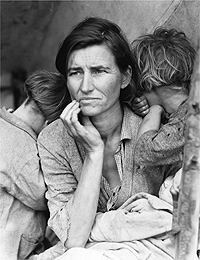First in a series on "Defining America."
Thousands of Americans are set adrift, jobless and hungry, reeling from nature's destructive power.
In 1930s America, the culprit was not a hurricane or flood, but the Dust Bowl, an ecological disaster that compounded with the Great Depression to send scores of farmers and their families packing their meager bags and seeking better fortunes (and weather) in California.
The epic drought that dried up the fertile soil of the Great Plains may have been the natural inverse of a flood, but the cultural parallels to Hurricane Katrina are unmistakable. History does, with ironic disparity, repeat itself.
Today marks the opening of "Defining America," an ambitious two-month long, multidisciplinary program produced by the Sun Valley Center for the Arts. With events to be held in several valley venues, "Defining America" studies Americans of the Great Depression and the government that brought them through the nation's darkest economic crisis.
By including music, film, and literature along with some of the most iconic images of the time, the SVCA program defines this formative chapter of American history through a variety of artistic mediums.
Kristin Poole, SVCA artistic director, said that although the show's planning began over a year ago, she cannot deny its timeliness.
"It's hard for me to separate it at this moment from current events—it's almost eerie," she said during the week following the Louisiana deluge.
Though current estimates of Gulf State emigrates are spotty, The New York Times reported last Wednesday that more than 200,000 New Orleans school children will need to be absorbed by districts around the country. With such high preliminary numbers, the cultural displacement in the aftermath of Katrina will likely rival that of the Dust Bowl's Okies.
If history does repeat itself, lasting art could again become the silver lining to otherwise dark clouds. It is too early to tell if the images streaming with the speed of the information age from the Gulf States will match the iconic products of the Depression. In the 1930s, both the migrations and their documentation were gradual developments.
The visual focus of "Defining America" will be photographic displays at the SVCA in Ketchum and Hailey's McKercher House (formerly the Hailey Cultural Center). Included in the show will be some of the earliest produced color photography.
"This town being what it is, there is a collector who purchased these images," Poole said of Michael Engl, a part-time valley resident.
A founder of the Community Library and The Community School, Engl is a regular patron of arts in the valley—"a pillar," according to Poole.
When Engl purchased the photographs from New York's Light Gallery in 1983, they had only recently been excavated from the Office of War Information where they had been lost following World War II. All told, there were 644 color images.
The pictures offer unprecedented views of a fascinating chapter of American history.
To deal with the developing domestic crises of the Depression and the Dust Bowl, Franklin D. Roosevelt's New Deal established far-reaching and ambitious programs, including the Works Progress Administration.
Among its many achievements, the WPA was responsible for building San Francisco's Golden Gate Bridge.
As an extension of the WPA, Roosevelt's Farm Security Administration enabled poverty-stricken sharecroppers to purchase land from the government and rise from desperate situations.
To promote public awareness of the projects, F.D.R. sent photographers and writers to document the ongoing struggles of southern farmers and westward-bound migrants. FSA photographers such as Dorothea Lange and Walker Evans eventually produced some of the Depression's iconic images, such as Lange's "Migrant Mother."
By its completion, the FSA produced 160,000 black-and-white negatives and 644 color Kodachrome shots.
Poole said the photos are the centerpiece of her show.
"These incredible photographs show a nation coming of age, struggling with priorities and developing values ... They're poignant, glorious images that tell us about ourselves," she said.
The show serves as a particularly moving commentary on issues relevant since Hurricane Katrina and the widely criticized handling of the disaster.
"'Defining America' is about the contract that citizens make with their government," Poole said.
"Defining America"
The show opens on Sept. 14. Events this month include free public film series featuring "Roll On, Columbia" and "Riding the Rails" beginning at 7 p.m. Sept 25 a Family Day from 3-5 p.m. Sept. 27 a docent tour at 11 a.m. Sept. 29 free film series continues with "Man in the Sand" at 7 p.m. All events take place at The Sun Valley Center for the Arts. Visit www.sunvalleycenter.org for further details.


 Thirty-two year old Florence Thompson was enshrined as Dorothea Lange's "Migrant Mother" when the photographer shot a series of photographs at a Nipomo, California labor camp in March, 1936. "Defining America" will feature one of Lange's series.
Thirty-two year old Florence Thompson was enshrined as Dorothea Lange's "Migrant Mother" when the photographer shot a series of photographs at a Nipomo, California labor camp in March, 1936. "Defining America" will feature one of Lange's series.



































